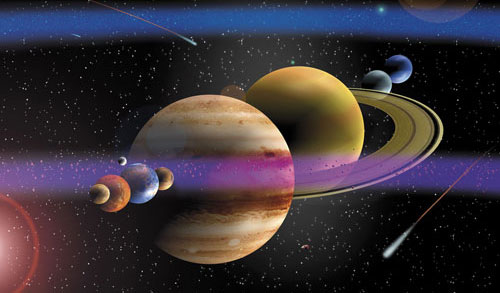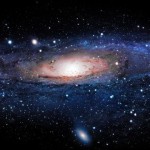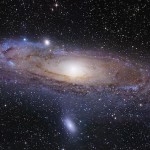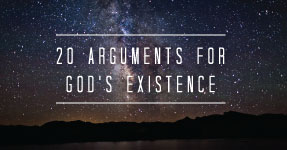Why Our Unique Solar System Points to God
by Thomas McAvoy
Filed under Cosmology
In an earlier post on this site titled "How Contemporary Physics Points to God", Fr. Robert Spitzer addresses the Big Bang and the five anthropic conditions that exist in of our universe. These anthropic conditions lead to intelligent life on our planet. Concerning the anthropic conditions Fr. Spitzer writes: “The odds against all five of the anthropic coincidences happening randomly is exceedingly and almost unimaginably improbable. Most reasonable and responsible individuals would not attribute this to random occurrence (because the odds are so overwhelmingly against it), and so, they look for another explanation which is more reasonable and responsible.”
The purpose of this posting is to point out additional, unique features of our solar system which are also very highly improbable. These features also allow for intelligent life on our planet. The discussion below is based on Lee Strobel’s book, The Case For A Creator. While Chapter 7 in Strobel’s book is excellent, he has two chapters justifying Intelligent Design and these chapters are extremely weak.. We can start from the general observation that in the universe there are billions of stars, and no doubt many of them have planets traveling around them. Surely there must be life on many of these planets. We can that demonstrate, using concrete facts, why Earth is indeed a very privileged and relatively unique planet. I would like to summarize a number of these arguments.
Stars exist in galaxies and there are three types of galaxies in the universe: spiral, elliptical, and irregular galaxies. Our galaxy, the Milky Way, is a spiral galaxy and our Sun resides far out from the galaxy’s center. At the center of probably all galaxies is a black hole, which is so dense that light cannot escape from it. Any matter that comes near a black hole is attracted to it by gravity, and as the matter speeds up a large amount of radiation is emitted. Stars near the center of a galaxy and far enough from the black hole can survive its gravitational pull, but they are subject to much more intense radiation than stars far away from the center of a galaxy. Since radiation is not conducive to life, it is good that our Sun is not near the center of our galaxy. Further the Sun’s almost circular galactic orbit keeps it far away from the center. In the case of elliptical and irregular galaxies, stars have orbits that cause them to visit the center of their galaxies, and thus be exposed to the dangerous radiation that exits there.
If one picks stars at random, then the most likely choice would be a red dwarf, since 76% of stars are red dwarfs. I don’t want to consider all star categories but rather focus on red dwarfs since they are the most common. Red dwarfs are less massive than our Sun, which is among the 10% most massive stars in the universe. Since they are smaller, red dwarfs don’t emit as much energy as our Sun, and as a result vegetation would be more difficult to grow on a planet orbiting them. They emit radiation in the red spectrum, which makes photosynthesis, the process by which plants grow, less efficient. To prevent its liquid water from freezing, a planet would have to orbit closer to a red dwarf than we do to our Sun. However, as one moves closer, tidal forces would increase and a planet would end up in a tidal-locked state where one side of the planet always faces the red dwarf and one always faces away. The side that faces the dwarf would be very hot and the one facing away would be very cold. These facts mean that vegetation would be more difficult to grow on a planet orbiting a red dwarf. Finally, red dwarfs don’t produce much ultraviolet light. Early on in a planet’s existence, ultraviolet light is hypothesized to break up water into hydrogen and oxygen. The hydrogen is a light gas and it escapes the planet’s gravitational pull and flows into space, while the oxygen, being a heavier gas, remains and supports life. By comparison not only is our Sun the right size but it produces the right mix of red and blue light. There are many more massive stars than our Sun, but they produce too much ultraviolet light compared to our Sun and planets orbiting them would be prone to experiencing strong ultraviolet radiation, which is not conducive to life. We are very fortunate to have a Sun with just the right properties to support life on Earth. If one picked a star at random, then the probability of finding one with just the right properties to sustain life on planets orbiting it would be astronomically small.
Next, consider our Moon, which, like the Sun, is critical to supporting life on the Earth. The Moon’s gravitational pull on the Earth stabilizes the tilt in the Earth’s axis of rotation. If this axis were not stable but varied, the result would be that over time the North Pole would migrate down toward the equator, and there would be tremendous changes in climate around the Earth. Areas that were once fertile, would become either too cold or too hot for crops to grow. As a result life would be confined to small compact niches and a large diversity of life probably would not exist. In fact, without the Moon, intelligent life might not exist at all. Mars has two moons but they are too small to stabilize its rotation, and thus, Mars’ axis of rotation varies widely. Our Moon is relatively large compared to the size of the Earth. The best hypothesis for its formation is that two planets collided just after the Earth’s formation. The collision angle had to be constrained. If the planets collided head on they would have annihilated one another; if the collision angle were too small the Earth’s gravity would not have been able to capture the Moon. How many times in the universe have two planets collided in the precisely necessary way that the Moon and Earth collided?
Now, finally, let's consider the Earth. If the Earth’s mass were much smaller, its gravity would not be strong enough to retain its atmosphere. If the Earth’s mass were too large then the pull of its gravity would be too large, and it would not be possible to have high mountains. There is so much water on the Earth that without mountains the entire surface of the Earth would be under water. Plate tectonics and the related continental drift are also important to sustaining life on Earth. Continental drift results in mountain formation and high ground for a diversity of life to exist. A planet also has to have a minimum size to keep the heat in its interior from being lost too quickly. Within the interior of the Earth radioactive reactions take place that generate heat. The result is that the iron in the Earth’s core remains molten, and the molten iron generates a magnetic field around the Earth. This magnetic field is crucial to life because it protects the Earth from damaging cosmic rays. Without the magnetic field more dangerous radiation from cosmic rays would reach the Earth’s surface and be harmful to life. The cosmic radiation would also strip away Earth’s atmosphere. How common is it in the universe to have a planet with a molten iron core? Not very.
In addition to the Earth's size and structure, consider its orbit, which is almost circular. If the orbit were more elliptical, then the Earth would either be too hot when it approached the Sun or too cold when it moved far away. If the radius of the Earth’s orbit were changed by ± 5% animal life would not be possible. The zone for animal life in the solar system is very narrow.
From these arguments one can conclude that only a very, very tiny fraction of stars would have just the right conditions for intelligent life as we know it to exist on a planet orbiting them. In our universe, primitive life is likely, but intelligent life is far more rare. When faced with the extremely low probability of these facts being a random occurrence one can look for explanations like the multiverse, which, while lacking any empirical evidence, posits millions of alternative universes. But in my own case I believe that the facts definitely point in the same direction that Fr. Spitzer discusses in his post, namely a super intellectual Creator.
Related Posts
Note: Our goal is to cultivate serious and respectful dialogue. While it's OK to disagree—even encouraged!—any snarky, offensive, or off-topic comments will be deleted. Before commenting please read the Commenting Rules and Tips. If you're having trouble commenting, read the Commenting Instructions.













